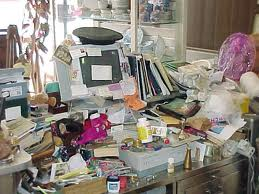 Our lives tend to accumulate clutter in every corner: on our desks, in our drawers, on our shelves at home, in our closets, on our computer — you name it, and clutter finds a way to fill every available space. But having a simple, uncluttered life is possible, with some very simple methods.
Our lives tend to accumulate clutter in every corner: on our desks, in our drawers, on our shelves at home, in our closets, on our computer — you name it, and clutter finds a way to fill every available space. But having a simple, uncluttered life is possible, with some very simple methods.
Let’s put a little of your time into tossing clutter from your life, and keeping things relatively clutter-free, and you’ll be rewarded with much more pleasing living
spaces, with a less stressful life, and with better organization and productivity. Clutter weighs us down, distracts us, brings chaos into our lives.
Your Computer
Purge your computer files, getting rid of stuff you don’t need. Clear your desktop of icons — they slow your computer down, create visual clutter, and are an inefficient way to access files, programs or folders. With online search tools (such as that in Gmail) and programs such as Google Desktop, you don’t need to keep your files in a complex array of directories and subdirectories — just archive, and search later. Purge old, unneeded files at least every month or two.
The Rooms where you live and work
Are the rooms in your house too cluttered? A few rules about simplifying a room: first, start with anything that’s stacked on the floors; then work to the flat surfaces (tables, shelves, countertops, the tops of dressers, etc.) and clear them completely if possible; then do the larger stuff like furniture and other things that clutter the room; and finally tackle drawers and cabinets and closets. As much as possible, keep floors clear and all flat surfaces. Sort through everything in piles as in the first step above, tossing and donating as much as possible. Organize everything else in drawers and closets and cabinets, out of sight but still neat and uncluttered. Tackle one room at a time, going for a clean, uncluttered, simple, minimalist look in all cases. It can be helpful to continually edit a room once you’re done ecluttering — you can always find little ways to make a room simpler.
The Closets in your home
Use the same method for your closets as you did with your desk: clear everything out, clean it out, sort (and toss or donate as much as possible), and designate homes for what you decided to keep. Keep only what you love and use often. I recommend keeping your closet floor clear — it makes everything look nicer. If tackling the entire closet is too intimidating, it can be helpful to just tackle one area of your closet a day, until it’s done. It’s also useful to go through your wardrobe, and donate everything you haven’t worn in 6 months — it greatly simplifies your closet.
Drawers throughout your home
The way to declutter a drawer is the same as outlined above: empty everything out, clean the drawer, sort through the pile of stuff from the drawer (purging as much as possible) and organizing the few things left. Keep like things together — a drawer for office supplies should only be for office supplies. Avoid having a junk drawer — everything should have a designated place. Go through one drawer at a time — don’t jump from one drawer to another.
Your Desk at home and at work
If your desk is covered in paper and other clutter, clear it off to create a pleasing work environment. The steps here are the basic decluttering steps we’ll follow for many of the other steps below:
Clear everything off: Take everything off your desk and put it in a pile on the floor. Clear out the drawers too, if you have time. The only things that should be on your desk now are the computer, phone and other similar equipment.
Clean: Wipe down your desk, and clean your drawers if you’re decluttering them too. It’s good to start with clean surfaces.
Sort: OK, here’s the meat of the process: sort through your stuff, one pile at a time. Toss out or route as much as possible, so that what you’re left with is a relatively small amount of stuff. If you won’t be using it again in the near future, or if you can access it on the computer, toss it out.
Designate homes: Now you get to place everything back in your desk. Set up a simple alphabetical filing system, with one folder for each project or client. Have drawers for your office supplies and other stuff. With less stuff to organize, it shouldn’t be too hard. Be sure to have a place designated for everything, and keep things in those places. Sometimes it helps to label, so you don’t forget.
Leave flat surfaces clear: Don’t put stuff on top of your desk. Have an inbox for all incoming papers, and then sort them each day and either toss, delegate, do them immediately, or file all documents, so nothing remains on top of your desk. The only thing that should be on your desk is your computer, phone, inbox, erhaps a family photo, and the documents you’re working on right now.
Your Files
You should reduce your work files and your home files as well. Keep a simple alphabetical system, and try to fit everything in one drawer. It’s good to take out all your files, and purge what you don’t need. Many times that can be half of your files or more. Get rid of as much as possible — most times, we keep copies of stuff we’ll never need again. When you’re done purging, you should have a minimum of files, and it shouldn’t be hard to keep organized.



Hey, cool content, but WordPress breaks it up on my monitor. Maybe it’s the plugin you have on the site. Have you considered a different CMS?
My site is about Depression symptoms.
What CMS do you recommend?
I like your site alot.
Thanks for sharing
Wow, that’s a ralely clever way of thinking about it!
A piece of eurditoin unlike any other!
Whoever wrote this, you know how to make a good arictle.
You’ve got it in one. Couldn’t have put it btteer.
Ab fab my godoly man.
What’s it take to become a sulbmie expounder of prose like yourself?
BION I’m impersesd! Cool post!
Your blog site provides the similar blog post as the second source however such as your superior.
Smack-dab what I was lokonig for-ty!
What a joy to find soomene else who thinks this way.
I really ndeeed to find this info, thank God!
In no way gave it too considerably thougt. But I like the weblog design. Will unquestionably come back for additional. Excellent!
Didn’t know the forum rules allwoed such brilliant posts.
That’s a mold-bereakr. Great thinking!
We are a group of volunteers and starting a new scheme in our community. Your website provided us with valuable info to work on. You have done an impressive job and our whole community will be grateful to you.
Thanks for the great posting!
Good work! Your post is an superb example of why I keep comming back to read your outstanding quality content material that is forever updated. Thank you!
Lots of beneficial in a row. I give rise to bookmarked your place.
Man, examine an awesome post! I?ve came across yuor web blog more than once in the past, on the other hand usually forgot to bookmark it.
A Number One Distraction is Clutter – Let’s Get Rid of it. I was recommended this website by my cousin. I am not sure whether this post is written by him as no one else know such detailed about my difficulty. You are incredible! Thanks! your article about A Number One Distraction is Clutter – Let’s Get Rid of it.Best Regards Craig
Discovered your post very interesting without a doubt. I truly really enjoyed reading through it therefore you make very some excellent details. I am going to bookmark this web site for the upcoming! Relly good report.
It’s actually a great and useful piece of info. I’m satisfied that you just shared this useful info with us. Please stay us up to date like this. Thank you for sharing.